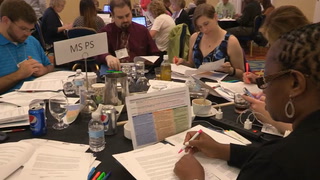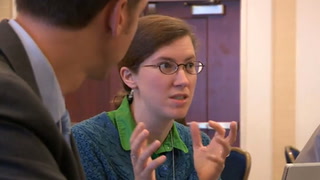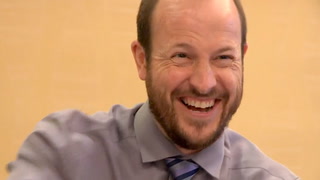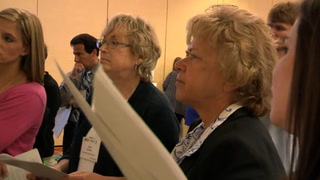NGSS EQuIP Rubric: Evidence of Student Learning Transcript
Chris: How will we know if students are learning? There's a lot of work to be done just on that.
Speaker 2: My name's [Elizabeth Burkson 00:00:10]. I'm with the Kansas team that's here at the conference. We're hoping to bring back to our state the deeper understanding of how to align lessons and how to align them to the next generation science standards and the equip rubric really helps us dive in to each one of the dimensions.
Chris: Just to situate yourself for monitoring student progress, this idea of embedded formative assessments and direct observable evidence of 3 dimensional learning. When do these things take place within a lesson? What can they look like over multiple lessons and what a unit looks like? It frames [crosstalk 00:00:50].
Hi. I'm Chris Carroll. The session that I ran today was around the idea of formative assessment. Specifically, around the idea of monitoring student progress. Going through the ideas of eliciting direct and observable evidence of 3 dimensional learning.
What would you all at your table define as evidence of learning? You have to have some sense of what they knew before and what they know now in order to gauge what has occurred there. Otherwise, you might be getting evidence of learning that happened months, years ago.
Speaker 2: I would say it would be the ability to apply and transfer so they may be able to apply what they've learned here but they're going to be able to put that in a different context, in another situation, and in another learning event.
Speaker 3: Also being able to either guide or support another learner so that they'll be articulating their learning but then also being able to teach it or present it in a different way to their peers.
Chris: I wanted them to discuss which of those pieces of evidence they felt gave really good information about what a student knew at a certain point in time.
Speaker 2: Unless you ask your students to produce something, it's hard to understand what they're really thinking.
Chris: One of the ways that we look at this idea of evidence is through this concept of an artifact. It's something that's generated by the student that gives you a representation of what their thinking at that given point in time. Let's put it in context of the lesson.
Speaker 2: We were asked to look at the wind turbine lesson and to actually pick out artifacts from the lesson.
Chris: You're going to find points within the lesson that you say there is something generated by the student at this point.
Speaker 2: Pieces of evidence of what a student would actually be doing.
Chris: Whether that's a graph, a table, an inscription, a writing sample, a model, whatever you feel that that's an artifact that shows some level of understanding by the student. You're trying to break down a lesson and look for very discrete, observable pieces where a student is being asked to do something or there's an interaction between students and teachers or student to student that you can then say, "Here's observable evidence of what a student knew at a given point in time." What the equip rubric affords is the ability to take a systematic approach to breaking those pieces down and really I think taking a closer look at making sure that they are happening.
Speaker 2: Went over to chart paper and as a group we were listing out the different pieces of evidence or artifacts. Was it implicit or explicit? We had a lot of debate within our group.
There are a couple of places where it says use the classroom discussion to highlight and it gives the teacher [crosstalk 00:03:51] It gives the teacher the next ... This is what you need to get them through from this but then how do you record that? Then is that really showing me what individual students know or is that just showing me what the whole class knows? Doesn't necessarily tell me that tomorrow if I go to Susie, she knows this list. [crosstalk 00:04:11]
Chris: Breakdown into smaller groups like the marker way, where they have the opportunity for each of them to demonstrate their understanding.
Speaker 2: Drawing up the design based on the criteria. Now you're getting into more assessing knowledge. If you get here and they're not doing that, then you have to make some decisions about feedback. [crosstalk 00:04:34] to see if they have the foundational knowledge to move on.
Chris: Another big piece for teachers is what information can I give back to a student based on what they hand made?
Speaker 2: Formative assessment is only formative if you do something with it.
Speaker 3: Exactly.
Speaker 2: It's just stuff you collect.
Speaker 3: Yeah, it has to drive instruction.
Chris: In terms of monitoring student progress, when they're asking students to complete something or do something, and they're turning it in to them or they're having a classroom discussion, what's the intent of this? Looking for students to understand this and I want them to work toward it. Knowing that ahead of time gives them intent to what kind of artifacts they want to collect or information they want to collect to monitor the student's progress.
The body of generated artifacts can really help to inform you as the teacher, right, and inform the student of their own learning, specifically around this idea of 3 dimensional understanding.












6 Comments
Jessica Byrd Dec 12, 2022 1:44pm
I believe formative assessment is to inform the teachers on the students progress and what the teacher my need to reteach.
Kimberley Legaspi Jan 21, 2022 11:03pm
I'd like to see it being done in a classroom.
Andrae McKay Jan 18, 2022 3:15pm
This was an excellent conversation. The fact that formative assessments are only formative if you do something with, speaks to the intentionality of the instructor for future lessons. Data collected should drive instruction.
What is intent? As an educator we're Looking for students to understand this ..........(concepts etc) and wanting them to work towards something.
Knowing ahead of time gives intent to what data/information to collect for monitoring student progress.
vanessa parnell Sep 29, 2020 2:33pm
Watching this video and who should I see? Nice to see you Melanie :)
Muyibat Folami Jan 21, 2018 9:11am